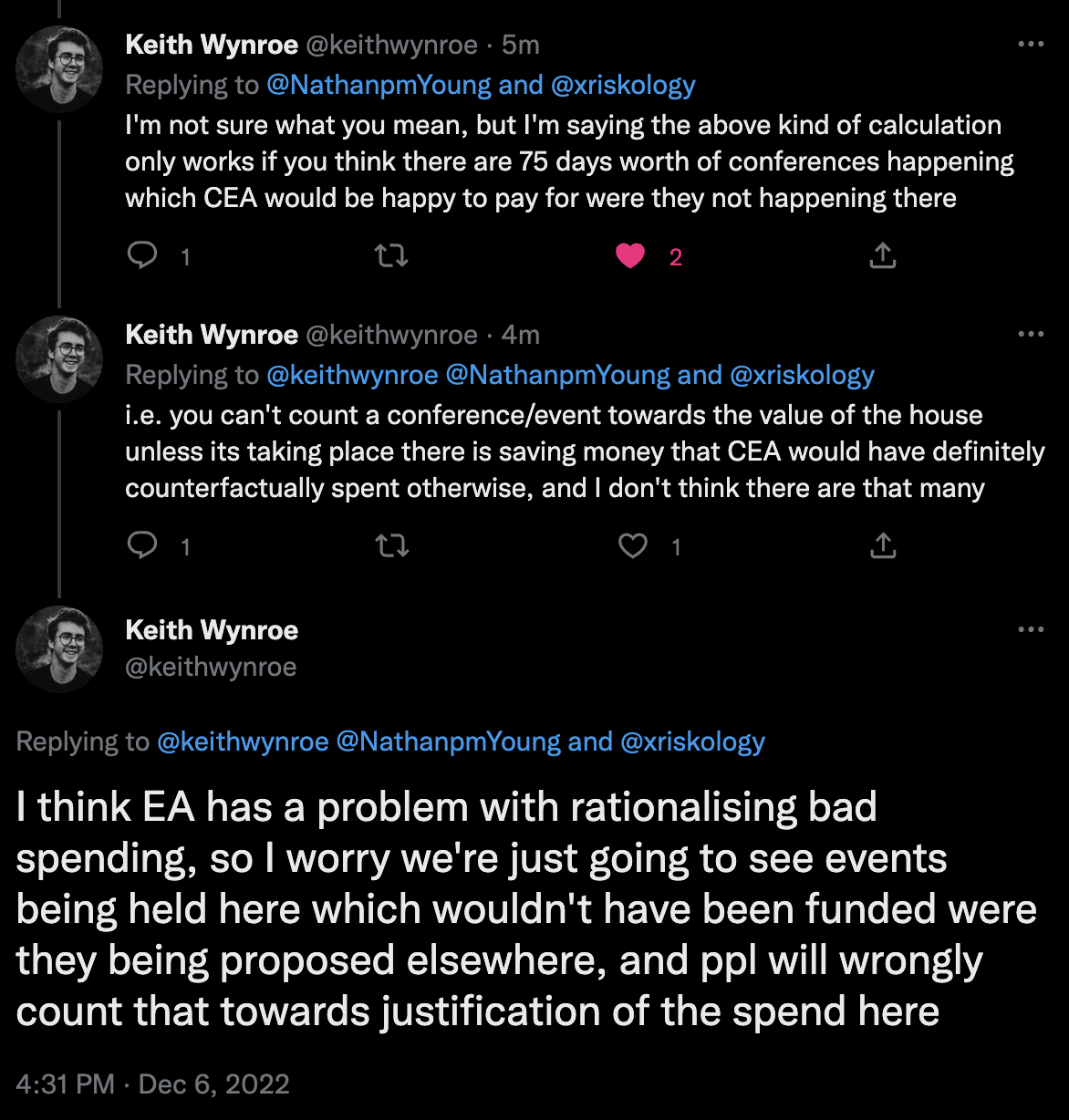Edit to add (9/1/2023): This post was written quickly and I judged things prematurely. I also regret not reaching out to Effective Ventures before posting it. Regarding my current opinion on the Abbey: I don't have anything really useful to say that isn't mentioned by others. The goal of this post was to ask a question and gather information, mostly because I was very surprised. I don't have a strong opinion on the purchase anymore and the ones I have are with high uncertainty. More thoughts in my case for transparent spending.
Yesterday morning I woke up and saw this tweet by Émile Torres: https://twitter.com/xriskology/status/1599511179738505216
I was shocked, angry and upset at first. Especially since it appears that the estate was for sale last year for 15 million pounds: https://twitter.com/RhiannonDauster/status/1599539148565934086
I'm not a big fan of Émile's writing and how they often misrepresent the EA movement. But that's not what this question is about, because they do raise a good point here: Why did CEA buy this property? My trust in CEA has been a bit shaky lately, and this doesn't help.
Apparently it was already mentioned in the New Yorker piece: https://www.newyorker.com/magazine/2022/08/15/the-reluctant-prophet-of-effective-altruism#:~:text=Last year%2C the Centre for Effective Altruism bought Wytham Abbey%2C a palatial estate near Oxford%2C built in 1480. Money%2C which no longer seemed an object%2C was increasingly being reinvested in the community itself.
"Last year, the Centre for Effective Altruism bought Wytham Abbey, a palatial estate near Oxford, built in 1480. Money, which no longer seemed an object, was increasingly being reinvested in the community itself."
For some reason I glanced over it at the time, or I just didn't realize the seriousness of it.
Upon more research, I came across this comment by Shakeel Hashim: "In April, Effective Ventures purchased Wytham Abbey and some land around it (but <1% of the 2,500 acre estate you're suggesting). Wytham is in the process of being established as a convening centre to run workshops and meetings that bring together people to think seriously about how to address important problems in the world. The vision is modelled on traditional specialist conference centres, e.g. Oberwolfach, The Rockefeller Foundation Bellagio Center or the Brocher Foundation.
The purchase was made from a large grant made specifically for this. There was no money from FTX or affiliated individuals or organizations." https://forum.effectivealtruism.org/posts/Et7oPMu6czhEd8ExW/why-you-re-not-hearing-as-much-from-ea-orgs-as-you-d-like?commentId=uRDZKw24mYe2NP4eq
I'm very relieved to hear money from individual donors wasn't used. And the <1% suggests 15 million pounds perhaps wasn't spent. Still, I'd love to hear and understand more about this project and why CEA thinks it's cost-effective. What is the EV calculation behind it?
Like the New Yorker piece points out, with more funding there has been a lot of spending within the movement itself. And that's fine, great even. This way more outreach can be done and the movement can grow. But we don't want to be too self-serving, and I'm scared too much of this thinking will lead to rationalizing lavish expenses (and I'm afraid this is already happening). There needs to be more transparency behind big expenses.
Edit to add: If this expense has been made a while back, why not announce it then?


I learned about this ten months ago, personally, and (in an informal peer context) spoke to one of the people involved about it. The person in question defended the decision by saying they intended to run retreats and ask "Hamming questions". They added that the £15m was an investment, since the castle ("technically it's not a castle") wouldn't depreciate in value. Also, they opined that the EA community as a whole shouldn't have a veto on every large purchase, because consensus decision-making is infeasible on that scale and is likely to result in vetos for tons of potentially valuable proposals.
I think I agree with the third point at least to some extent, but that's a meta level point, and the object level points did not seem like good arguments for buying a £15m castle. I came away from the conversation believing this was not a reasonable use of funds and with my opinion of CEA* lowered.
I didn't, and still don't, know what to do about this sort of thing. Changing how an EA org acts is hard; maybe public pressure helps, but I suspect a lot of the difficulties are in changing organizational norms and policies, and I don't have a good sense of what would be useful policies or what wouldn't be. I do have the intuition that having a larger number of distinct EA orgs would be good, so CEA has less influence individually.
*I understand CEA to be an umbrella organization housing a number of sub-orgs, and so I remain unsure how far this negative update should propagate; certainly I'm sure there are folks who work in other branches of CEA who had nothing to do with this and no say in it.
[ETA: Changed "their decision" to "the decision" upon receiving a reminder that the person in question was (probably) not the person who had actually made the original decision to buy the castle.]
If you're an organisation that solicits donations part of your basic obligations in your relationship with your donors is to be clear about whatyyou have spent money on in the past, and intend to spend it on in the future, so that people can look at that and make a reasonable judgement about what their donation is likely to be used for